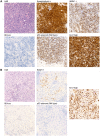Defining triple-negative breast cancer with neuroendocrine differentiation (TNBC-NED)
- PMID: 37082801
- PMCID: PMC10240148
- DOI: 10.1002/cjp2.318
Defining triple-negative breast cancer with neuroendocrine differentiation (TNBC-NED)
Abstract
Primary breast neuroendocrine (NE) neoplasms are uncommon, and definitions harbor controversy. We retrospectively collected 73 triple-negative breast cancers (TNBC) and evaluated NE biomarker expression along with p53 aberrant staining (which correlates with TP53 gene mutation) and Rb protein loss by immunohistochemistry. In the study cohort, we found 11 (15%) cases of TNBC with neuroendocrine differentiation (TNBC-NED) showing positivity for one or more NE markers (synaptophysin/chromogranin/insulinoma-associated protein 1 [INSM1]). We also identified one separate small cell neuroendocrine carcinoma. Histologic types for these 11 TNBC-NED cases were as follows: 8 invasive ductal carcinoma (IDC) not otherwise specified (NOS), 2 IDC with apocrine features, 1 IDC with solid papillary features. INSM1 had the highest positivity and was seen in all 11 carcinomas. Seven (64%) cases showed p53 aberrant staining, 6 (55%) had Rb protein loss, while 6 (55%) had p53/Rb co-aberrant staining/protein loss. TNBC-NED was associated with Rb protein loss (p < 0.001), as well as p53/Rb co-aberrant staining/protein loss (p < 0.001). In 61 cases negative for NE markers, 37 (61%) showed p53 aberrant staining, while 5 (8%) had Rb protein loss. We also analyzed genomic and transcriptomic data from The Cancer Genome Atlas (TCGA) PanCancer Atlas of 171 basal/TNBC patients. Transcriptomic analysis revealed mRNA expression of RB1 to be correlated negatively with SYN1 mRNA expression (p = 0.0400) and INSM1 mRNA expression (p = 0.0106) in this cohort. We would like to highlight the importance of these findings. TNBC-NED is currently diagnosed as TNBC, and although it overlaps morphologically with TNBC without NED, the unique p53/Rb signature highlights a genetic overlap with NE carcinomas of the breast.
Keywords: RB1; TNBC-NED; TP53; breast; carcinoma; neuroendocrine.
© 2023 The Authors. The Journal of Pathology: Clinical Research published by The Pathological Society of Great Britain and Ireland and John Wiley & Sons Ltd.
Figures


Similar articles
-
Nuclear Insulinoma-Associated Protein 1 Expression as a Marker of Neuroendocrine Differentiation in Neoplasms of the Breast.Int J Surg Pathol. 2021 Aug;29(5):496-502. doi: 10.1177/1066896920985938. Epub 2021 Jan 9. Int J Surg Pathol. 2021. PMID: 33426999
-
Genetic and immunohistochemical profiling of small cell and large cell neuroendocrine carcinomas of the breast.Mod Pathol. 2022 Oct;35(10):1349-1361. doi: 10.1038/s41379-022-01090-y. Epub 2022 May 19. Mod Pathol. 2022. PMID: 35590107 Free PMC article.
-
Expression of novel neuroendocrine markers in breast carcinomas: a study of INSM1, ASCL1, and POU2F3.Hum Pathol. 2022 Sep;127:102-111. doi: 10.1016/j.humpath.2022.06.003. Epub 2022 Jun 8. Hum Pathol. 2022. PMID: 35690220 Free PMC article.
-
INSM1 Is Less Sensitive But More Specific Than Synaptophysin in Gynecologic High-grade Neuroendocrine Carcinomas: An Immunohistochemical Study of 75 Cases With Specificity Test and Literature Review.Am J Surg Pathol. 2021 Feb 1;45(2):147-159. doi: 10.1097/PAS.0000000000001641. Am J Surg Pathol. 2021. PMID: 33264139 Review.
-
Diagnostic Value of Insulinoma-Associated Protein 1 (INSM1) and Comparison With Established Neuroendocrine Markers in Pulmonary Cancers.Arch Pathol Lab Med. 2020 Sep 1;144(9):1075-1085. doi: 10.5858/arpa.2019-0250-OA. Arch Pathol Lab Med. 2020. PMID: 31913660 Review.
Cited by
-
Neuroendocrine Neoplasms of the Breast: Current Insights and Future Directions.Cancer Rep (Hoboken). 2024 Nov;7(11):e70059. doi: 10.1002/cnr2.70059. Cancer Rep (Hoboken). 2024. PMID: 39585672 Free PMC article. Review.
References
-
- Feyrter F, Hartmann G. On the carcinoid growth form of the carcinoma mammae, especially the carcinoma solidum (gelatinosum) mammae. Frankf Z Pathol 1963; 73: 24–39. - PubMed
-
- Tan PH, Ellis I, Allison K, et al. The 2019 World Health Organization classification of tumours of the breast. Histopathology 2020; 77: 181–185. - PubMed
-
- Tang F, Wei B, Tian Z, et al. Invasive mammary carcinoma with neuroendocrine differentiation: histological features and diagnostic challenges. Histopathology 2011; 59: 106–115. - PubMed
MeSH terms
Substances
LinkOut - more resources
Full Text Sources
Medical
Research Materials
Miscellaneous

